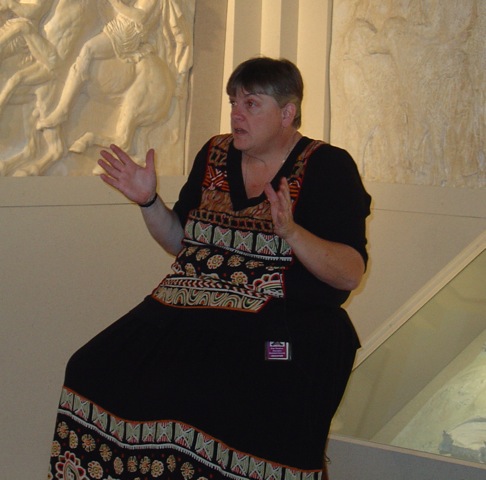If you’re looking for things to do this winter that’ll take you out of the house while keeping you warm, head over to the Spurlock Museum of World Cultures at the University of Illinois at Urbana-Champaign for one, or both, of their winter story telling events. This winter, the Spurlock Museum will be hosting, “Silly Stories Afternoon” and “Stories to Warm Your Heart” in December and January, respectively. Kim Sheahan, the museum’s Assistant Director of Education and resident storyteller, is well aware that being cooped up inside during the bitter cold of winter can make us all a bit stir crazy, and is pleased to offer free, family friendly events to break up the monotony.
The Spurlock Museum has a long tradition of storytelling. Every year on the Saturday before Halloween ghost stories are told for children from kindergarten to sixth grade in the morning and an adult ghost story session in the evening. “Winter Tales” is presented in February. Storytelling is also provided at the museum’s Crafternoon events. Sheahan believes that stories are an important educational tool and “one of the best ways to connect people with objects and cultures.” Sheahan and the Spurlock Museum work hard to integrate stories into their exhibits and events as a way to engage people of all ages and backgrounds.
Sheahan says that one of the ways she knew she was a storyteller was when she realized she was like her father. If you asked her father a question, Sheahan told me, you get a 20-minute answer, probably with a tangent along the way. And the same is true of Sheahan, her tangents detailing previous storytelling fails and successes,as you take a well-crafted detour back to where your question was leading in the first place.
Some might think of tangents as extraneous, but Sheahan believes that all stories have a purpose. In general, stories can help teach us lessons about what people value and provide context for people, things, and events. Sheahan enjoys using stories as a tool for exactly this reason. Telling tales is an especially useful tool for younger children who have trouble staying focused. Stories act as a way to reinvigorate a bored child or audience, provide explanation to points that were unclear, and cement in the mind, why people, places, and objects are important. One of the characteristics of a good storyteller, Sheahan says, is being able to read an audience, understand when a story is needed, and what kind of story is needed.

A good storyteller should take the listener down a path, describing things well, but also leaving things undescribed. By doing this the storyteller can “disappear out of the story” Sheahan told me. It’s okay to allow the listener to decide how some things in the story should be based on their own imagination. If certain details of the story aren’t fundamental to the plot, let the listener decide what kind of dog the main character has or what color dress they’re wearing. This allows the listener to guide parts of the story in their mind, which is all a part of the partnership between teller and listener, says Sheahan. The teller is responsible for adapting or modifying the story based on audience feedback, and the audience should be prepared with an open mind and ready imagination.
What’s truly impressive about storytellers like Sheahan is that they have most of their stories memorized, or at least the plot memorized. Sheahan’s mentor can pick and choose from hundreds of stories he has memorized based on the audience and, at events with multiple tellers, based on the stories the tellers before him decide to share. It’s important to understand that this memorization isn’t word for word. According to Sheahan, the teller should know the plot of the story, guide the audience from point A to point B within the plot, and make changes or adjustments as needed. If the story is a long one, like the story of the Trojan War for example, but you have an audience of 8 year olds, the teller will likely need to cut out the gore and shorten the story by sticking to key plots points. As with anything, it’s important to know your audience.

Not only are good storytellers important, but also storytelling telling the story in general is important. It aids in the “preservation of heritage,” says Sheahan, it helps the audience remember and appreciate objects, people, and events about which they are learning, and it aids in literacy. If you tell a child a story, and can get that child to fall in love with the story, more often than not, that child will then search for other ways to consume the story. They’ll want to hear it from other people, and eventually, learn how to engage with the story on their own by reading. Children and adults of all ages should be encouraged to listen to stories and challenge their imaginations, contends Sheahan. She and the Spurlock Museum are fully prepared and ready to take on this challenge.
- Silly Stories will take place on Saturday, December 10 at 2pm.
- Stories to Warm Your Heart will be held on Saturday, January 7 at 2pm.
- Winter Tales will be on Saturday, February 18 at 2pm.
To find out about the Spurlock Museum’s other events featuring storytelling, check out their event page.
If you are a UIUC student studying for finals, you can take a break at the Spurlock Museum from 1-4 p.m. on December 8, 9, and 10. The free study break will have a craft bar, board games, yoga & medidation, as well as multicultural short films.
Photos courtesy of The Spurlock Museum, University of Illinois at Urbana-Champaign.








